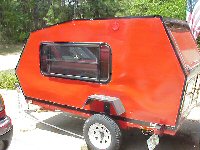Hi everyone,
This is my first post. I did search the forum and found some information, but not exactly what I'm looking for. Short version: what solutions do people use for ventilation while boondocking in heavy rain?
Long version: every year I do a week long camping trip in a primitive campsite. That's a full week with no electric hookup, no generators, etc. Over the past few years several times there have been torrential rains that flooded the campsite. The temperature can also get up to 100 degrees Fahrenheit. We've had some high winds that have destroyed pop up campers and blown tents away. I typically tent camp but I'd like a little more protection from the weather. However, I'm curious how a teardrop or cargo conversion would handle ventilation in this circumstance. Even using 12v computer fans with some kind of covered vents seems like it would wear down batteries after a few days. It seems like you would need a roof vent with one of those rain covers, and possibly a few other small covered vents on the sides that could be opened without allowing water in.
Thanks for your time!
Vents, rain, and boondocking
14 posts
• Page 1 of 1
Re: Vents, rain, and boondocking
Shawn,
Welcome to the group!
A vent cover would be very handy in a hot humid camping scenario with lots or rain.
Many use an easy up type tent over their trailers, both for shade, and rain protection.
If you are camping in high winds, that probably isn't a good option...staying hooked up to the tow car is though!
If you use awning style windows you can leave them partly open in all but driving rain.
A vent in the floor, or protected wall vents help too.
Which would work best for you depends on the trailer style and floorplan.
If you plan to spend a lot of time inside in 100 degree temps while it is raining, I don't think any ventilation system short of A/C will be very comfortable!
I have a floor vent in my standie with a fan that draws air from under the trailer, and the usual roof vent and windows. During a rain, we vent what we can, but it can still be sticky.
Static ventilation, if you are concerned about energy use, will be tough. You will need a lot of square feet of window or vent space if using power assist is not an option.
Rob
Welcome to the group!

A vent cover would be very handy in a hot humid camping scenario with lots or rain.
Many use an easy up type tent over their trailers, both for shade, and rain protection.
If you are camping in high winds, that probably isn't a good option...staying hooked up to the tow car is though!
If you use awning style windows you can leave them partly open in all but driving rain.
A vent in the floor, or protected wall vents help too.
Which would work best for you depends on the trailer style and floorplan.
If you plan to spend a lot of time inside in 100 degree temps while it is raining, I don't think any ventilation system short of A/C will be very comfortable!

I have a floor vent in my standie with a fan that draws air from under the trailer, and the usual roof vent and windows. During a rain, we vent what we can, but it can still be sticky.
Static ventilation, if you are concerned about energy use, will be tough. You will need a lot of square feet of window or vent space if using power assist is not an option.
Rob
Waiting for "someday" will leave you on your deathbed wondering why you didn't just rearrange your priorities and enjoy the time you had, instead of waiting for a "better" time to come along...
-

48Rob - Super Lifetime Member
- Posts: 3882
- Images: 4
- Joined: Thu Nov 17, 2005 6:47 pm
- Location: Central Illinois



